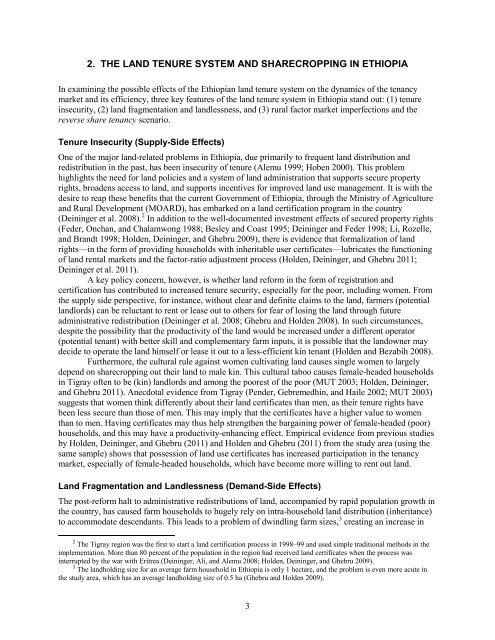Reverse-Share-Tenancy and Marshallian Inefficiency - International ...
Reverse-Share-Tenancy and Marshallian Inefficiency - International ...
Reverse-Share-Tenancy and Marshallian Inefficiency - International ...
Create successful ePaper yourself
Turn your PDF publications into a flip-book with our unique Google optimized e-Paper software.
2. THE LAND TENURE SYSTEM AND SHARECROPPING IN ETHIOPIA<br />
In examining the possible effects of the Ethiopian l<strong>and</strong> tenure system on the dynamics of the tenancy<br />
market <strong>and</strong> its efficiency, three key features of the l<strong>and</strong> tenure system in Ethiopia st<strong>and</strong> out: (1) tenure<br />
insecurity, (2) l<strong>and</strong> fragmentation <strong>and</strong> l<strong>and</strong>lessness, <strong>and</strong> (3) rural factor market imperfections <strong>and</strong> the<br />
reverse share tenancy scenario.<br />
Tenure Insecurity (Supply-Side Effects)<br />
One of the major l<strong>and</strong>-related problems in Ethiopia, due primarily to frequent l<strong>and</strong> distribution <strong>and</strong><br />
redistribution in the past, has been insecurity of tenure (Alemu 1999; Hoben 2000). This problem<br />
highlights the need for l<strong>and</strong> policies <strong>and</strong> a system of l<strong>and</strong> administration that supports secure property<br />
rights, broadens access to l<strong>and</strong>, <strong>and</strong> supports incentives for improved l<strong>and</strong> use management. It is with the<br />
desire to reap these benefits that the current Government of Ethiopia, through the Ministry of Agriculture<br />
<strong>and</strong> Rural Development (MOARD), has embarked on a l<strong>and</strong> certification program in the country<br />
(Deininger et al. 2008). 2 In addition to the well-documented investment effects of secured property rights<br />
(Feder, Onchan, <strong>and</strong> Chalamwong 1988; Besley <strong>and</strong> Coast 1995; Deininger <strong>and</strong> Feder 1998; Li, Rozelle,<br />
<strong>and</strong> Br<strong>and</strong>t 1998; Holden, Deininger, <strong>and</strong> Ghebru 2009), there is evidence that formalization of l<strong>and</strong><br />
rights—in the form of providing households with inheritable user certificates—lubricates the functioning<br />
of l<strong>and</strong> rental markets <strong>and</strong> the factor-ratio adjustment process (Holden, Deininger, <strong>and</strong> Ghebru 2011;<br />
Deininger et al. 2011).<br />
A key policy concern, however, is whether l<strong>and</strong> reform in the form of registration <strong>and</strong><br />
certification has contributed to increased tenure security, especially for the poor, including women. From<br />
the supply side perspective, for instance, without clear <strong>and</strong> definite claims to the l<strong>and</strong>, farmers (potential<br />
l<strong>and</strong>lords) can be reluctant to rent or lease out to others for fear of losing the l<strong>and</strong> through future<br />
administrative redistribution (Deininger et al. 2008; Ghebru <strong>and</strong> Holden 2008). In such circumstances,<br />
despite the possibility that the productivity of the l<strong>and</strong> would be increased under a different operator<br />
(potential tenant) with better skill <strong>and</strong> complementary farm inputs, it is possible that the l<strong>and</strong>owner may<br />
decide to operate the l<strong>and</strong> himself or lease it out to a less-efficient kin tenant (Holden <strong>and</strong> Bezabih 2008).<br />
Furthermore, the cultural rule against women cultivating l<strong>and</strong> causes single women to largely<br />
depend on sharecropping out their l<strong>and</strong> to male kin. This cultural taboo causes female-headed households<br />
in Tigray often to be (kin) l<strong>and</strong>lords <strong>and</strong> among the poorest of the poor (MUT 2003; Holden, Deininger,<br />
<strong>and</strong> Ghebru 2011). Anecdotal evidence from Tigray (Pender, Gebremedhin, <strong>and</strong> Haile 2002; MUT 2003)<br />
suggests that women think differently about their l<strong>and</strong> certificates than men, as their tenure rights have<br />
been less secure than those of men. This may imply that the certificates have a higher value to women<br />
than to men. Having certificates may thus help strengthen the bargaining power of female-headed (poor)<br />
households, <strong>and</strong> this may have a productivity-enhancing effect. Empirical evidence from previous studies<br />
by Holden, Deininger, <strong>and</strong> Ghebru (2011) <strong>and</strong> Holden <strong>and</strong> Ghebru (2011) from the study area (using the<br />
same sample) shows that possession of l<strong>and</strong> use certificates has increased participation in the tenancy<br />
market, especially of female-headed households, which have become more willing to rent out l<strong>and</strong>.<br />
L<strong>and</strong> Fragmentation <strong>and</strong> L<strong>and</strong>lessness (Dem<strong>and</strong>-Side Effects)<br />
The post-reform halt to administrative redistributions of l<strong>and</strong>, accompanied by rapid population growth in<br />
the country, has caused farm households to hugely rely on intra-household l<strong>and</strong> distribution (inheritance)<br />
to accommodate descendants. This leads to a problem of dwindling farm sizes, 3 creating an increase in<br />
2 The Tigray region was the first to start a l<strong>and</strong> certification process in 1998–99 <strong>and</strong> used simple traditional methods in the<br />
implementation. More than 80 percent of the population in the region had received l<strong>and</strong> certificates when the process was<br />
interrupted by the war with Eritrea (Deininger, Ali, <strong>and</strong> Alemu 2008; Holden, Deininger, <strong>and</strong> Ghebru 2009).<br />
3 The l<strong>and</strong>holding size for an average farm household in Ethiopia is only 1 hectare, <strong>and</strong> the problem is even more acute in<br />
the study area, which has an average l<strong>and</strong>holding size of 0.5 ha (Ghebru <strong>and</strong> Holden 2009).<br />
3
















